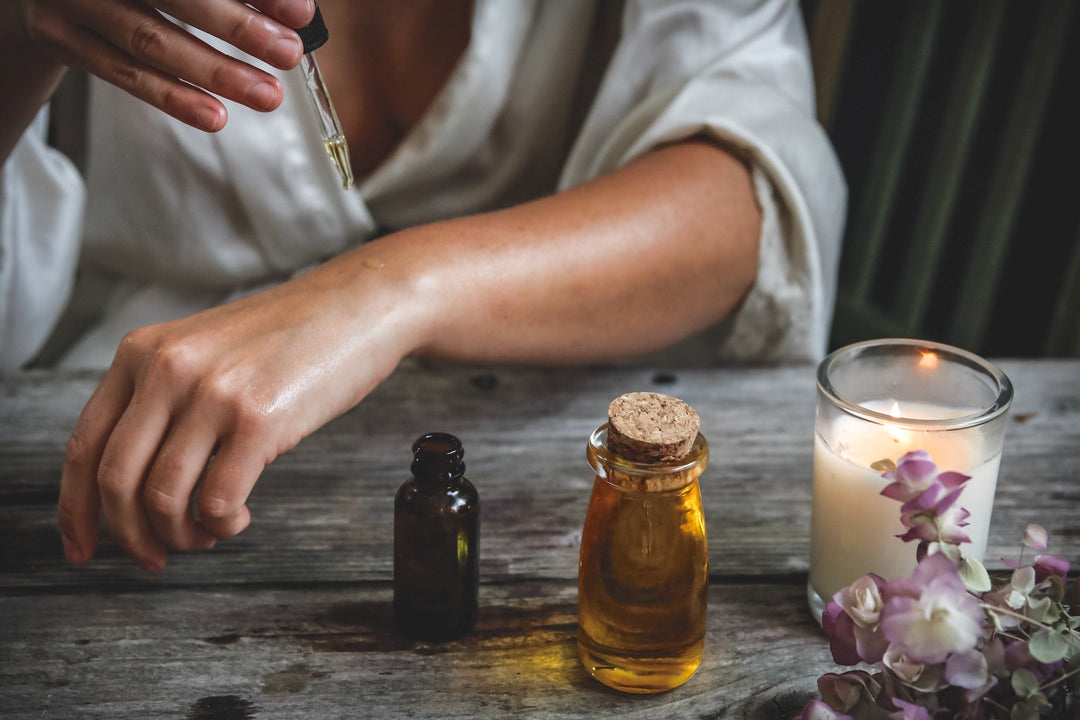
If you’re like most people on the planet, you didn’t learn in anatomy class that humans, like all vertebrates — from the clownfish to the kangaroo — have an endocannabinoid system (ECS) that regulates your body's other systems and organs.
But yes, you do indeed have an endocannabinoid system, and it’s the secret to why CBD and other phytocannabinoids are among the world’s most effective skincare ingredients.
By the way, since many people ask us, and it’s a tough word to say, here’s how to pronounce endocannabinoid system: ˌen-dō- kə-ˈna-bə-ˌnȯid ˈsi-stəm (emphasis on the NA in canNAbinoid).
The purpose of the endocannabinoid system
What does the endocannabinoid system do? The whole point of your ECS is to maintain homeostasis, or balance, throughout your body. Think of your ECS as a wise internal communicator, working to keep everything in balance and functioning smoothly, from sleep and appetite to mood and inflammation.
For example, when your body temperature gets too cold or too hot, your ECS kicks in by sending endocannabinoids to bind with and instruct receptors to bring your temperature back to normal.
In essence, your ECS is in charge of keeping you feeling well.
What is the endocannabinoid system responsible for?
If you came here asking, “Does the endocannabinoid system affect skin?” The answer is yes. In fact, your ECS controls many of your body's most crucial functions, including, among others:
-
Skin and nerve function
-
Inflammation and immune response
-
Pain
-
Appetite, digestion, metabolism
-
Sleep and energy level
-
Mood, stress, anxiety
-
Memory and learning
-
Reproduction and fertility
-
Muscle and bone growth
If your body isn't functioning optimally in any of these areas, you may not be producing enough endocannabinoids, for a variety of reasons (more on that later). This is when you might consider supplementing with phytocannabinoids — phyto meaning plant-based — such as CBD, CBDa, CBG, CBN, and dozens of others, which are found in abundance in cannabis and hemp.
(Side note: Cannabis and hemp are actually the same plant species, Cannabis sativa. The key difference is how much THC each contains. In the US, hemp can contain only trace amounts of THC, 0.3% or less.)
When was the endocannabinoid system discovered?
If you hadn’t heard of the endocannabinoid system before, it’s likely because it was only discovered relatively recently. In fact, one of the most common Google searches related to the ECS is: “Is the endocannabinoid system real?”
Yes, it’s real. It’s hard to believe that in this day and age of modern medicine, new (or misunderstood) bodily systems and organs are still being discovered. But they are! Did you catch the headline news in 2017 that scientists ‘discovered’ a new organ in the gut called mesentery, discussed here on CNN?
Similar to the mesentery, your endocannabinoid system isn’t new; researchers just hadn’t figured it out yet. Scientists estimate that the human body developed the endocannabinoid system more than 600 million years ago.
Read on to understand what the endocannabinoid system is and does, and how CBD skin care products can aid in healing nine common skin issues.
What is the endocannabinoid system, exactly?
The endocannabinoid system explained: The ECS is one of your body’s biological systems and is made up of three main components:
-
Endocannabinoids, short for endogenous cannabinoids, are neurotransmitters naturally produced by your body as needed to keep internal functions running smoothly.
-
Cannabinoid receptors are sensitive molecules that bind with cannabinoids, whether made by your body or a plant, and respond by signaling your body to take action, such as telling your immune cells to calm inflammation.
-
Regulatory enzymes break down the cannabinoids once they’ve carried out their function.
Together, these endocannabinoids, receptors, and enzymes create a complex communication system in charge of keeping pretty much everything in your body in check. The ECS is the master regulator for every major system in the body, from the nervous, respiratory, digestive, and endocrine systems, to the reproductive, lymphatic, and immune systems.
“This signaling system has a recognized activity on nervous system development, synaptic plasticity, learning and memory, neuroinflammation, pain and neurodegeneration, stress responsivity, mood and behavior, food intake and metabolism, reproduction, fertility and pregnancy, immune response, cardiac functions, cancer progression, and so much more,” writes Dr. Rosaria Meccariello in the International Journal of Molecular Sciences.
The ECS also regulates our integumentary system, a.k.a. our skin, our body’s largest organ.
Cannabinoid receptors permeate the body and are in every organ, including skin. Researchers have identified two types of cannabinoid receptors so far: CB1 in the nervous system, connective tissues, organs, glands and gonads; and CB2 in the immune system. Many tissues, including skin, contain both CB1 and CB2 receptors, each serving a unique function. This is the key to how CBD and other phytocannabinoids can rebalance skin, regardless of what is causing the imbalance.
What happens when the endocannabinoid system doesn’t function properly?
Now you know your endocannabinoid system — named after cannabis because the ECS was discovered while studying the effects of cannabis on the brain — produces natural endocannabinoids that flow through your body at all times. And you know the endocannabinoids’ function is to bind with receptors to maintain balance in your body’s organs and systems.
The body generally does an amazing job maintaining this balance on its own. But sometimes things like stress, hormones, illness, toxins, and pollution overwhelm the system and the body can’t produce enough natural endocannabinoids to keep up, leading to imbalance. Researchers have named this phenomenon Clinical Endocannabinoid Deficiency.
In a research paper on endocannabinoid system deficiency published in the National Library of Medicine, board-certified neurologist and psychopharmacology researcher Dr. Ethan B. Russo explains that an imbalance in endocannabinoids can lead to these endocannabinoid deficiency symptoms, among others:
-
A lower pain threshold
-
Disruptions in digestion, mood, and sleep
-
Skin disorders
“There are more cannabinoid receptors in the brain than there are for all the neurotransmitters put together,” notes Dr. Russo. Obviously that means the endocannabinoid system has the potential to have a powerful impact on the body. It’s a significant part of the makeup of every human being, and it can have a substantial effect on our health.
So how do we get our endocannabinoid system back in balance? This is where cannabis comes in.
You can replenish your ECS by supplementing with plant-based phytocannabinoids, internally and externally.
9 skin conditions affected by your endocannabinoid system
There are cannabinoid receptors all over your skin, and in every layer of it, including the surface (epidermis), oil glands (sebaceous glands), hair follicles, nerves, immune cells, and subcutaneous fat.
When your body’s natural endocannabinoids aren’t able to keep your skin in harmony, it can lead to:
-
Acne
-
Oiliness
-
Dryness
-
Itchiness
-
Redness
-
Oxidative stress
-
Hyperpigmentation
-
Pain
-
Inflammation
Because the cannabinoid receptors in your skin bind with endocannabinoids as well as phytocannabinoids, you can address these imbalances with topical hemp products, such as oils and creams. Phytocannabinoids fill in when your body’s natural endocannabinoids aren’t cutting it on their own. Applied topically, phytocannabinoids — CBD, CBDa, CBG, CBN and dozens of others — bind with these cannabinoid receptors in your skin and signal them to create balance where needed.
Let that sink in. We had a major "Aha!" moment when we discovered this. Cannabis sativa really is a wonder-plant. And we love science!
Cannabinoids and skin
Phytocannabinoids have additional qualities that make them ideal for skincare: they have scientifically-proven antioxidant, anti-inflammatory, protective, regenerative, and antibacterial properties.
While a 50-year ban on cannabis research in the US was in effect until recently, there’s a fast-growing body of scholarly research that explains how your skin’s endocannabinoid system influences and balances every layer, cell, and component of your skin — affecting all nine skin issues above.
A study published in November 2023 in the International Journal of Molecular Sciences concludes: "Preliminary studies indicate cannabinoids can improve eczema, acne, pruritus, psoriasis, hair growth, and skin cancer and have anti-aging effects on skin."
The science has evolved enough that we now know there are specific cannabinoids for skin diseases and hair regrowth, such as CBD and CBDa, and CBD skin care benefits. From the “Skin Applications of Cannabidiol” study published in March 2023 in the journal Phytochem:
“There is already an important amount of scientific evidence which proves the benefits and therapeutic applications of CBD. CBD has several skin biological properties that make it a compound that can simultaneously act on different targets of multifactorial diseases such as ATD, psoriasis, acne, epidermolysis bullosa, systemic sclerosis, seborrheic dermatitis, scalp psoriasis, androgenetic alopecia and melanoma.”
Here’s another good paper if you’d like to dive deeper: Cannabinoid Signaling in the Skin: Therapeutic Potential, published in the journal Molecules in 2019. It covers acne, atopic dermatitis, fibrosis, hair growth, inflammation, itch, psoriasis, tumors, wound healing, and more.
CBD for skin healing
The most important way you can support your skin and your endocannabinoid system is actually through healthy living. Get good sleep. Move your body. Nourish yourself with nutrient-dense food. Proactively reduce your stress levels. Spend time with people who bring you joy.
And if your skin still gets out of balance, consider supplementing with topical phytocannabinoids. Our extremely loyal customers — our Bee-lievers — will tell you that skin health improves when the endocannabinoid system is properly replenished.
Thank you for staying curious and for wanting to learn about the truly fascinating but little-understood endocannabinoid system. If you want to learn more about how to supplement your ECS to improve and protect your skin, we invite you to discover our skincare line here.




Leave a comment